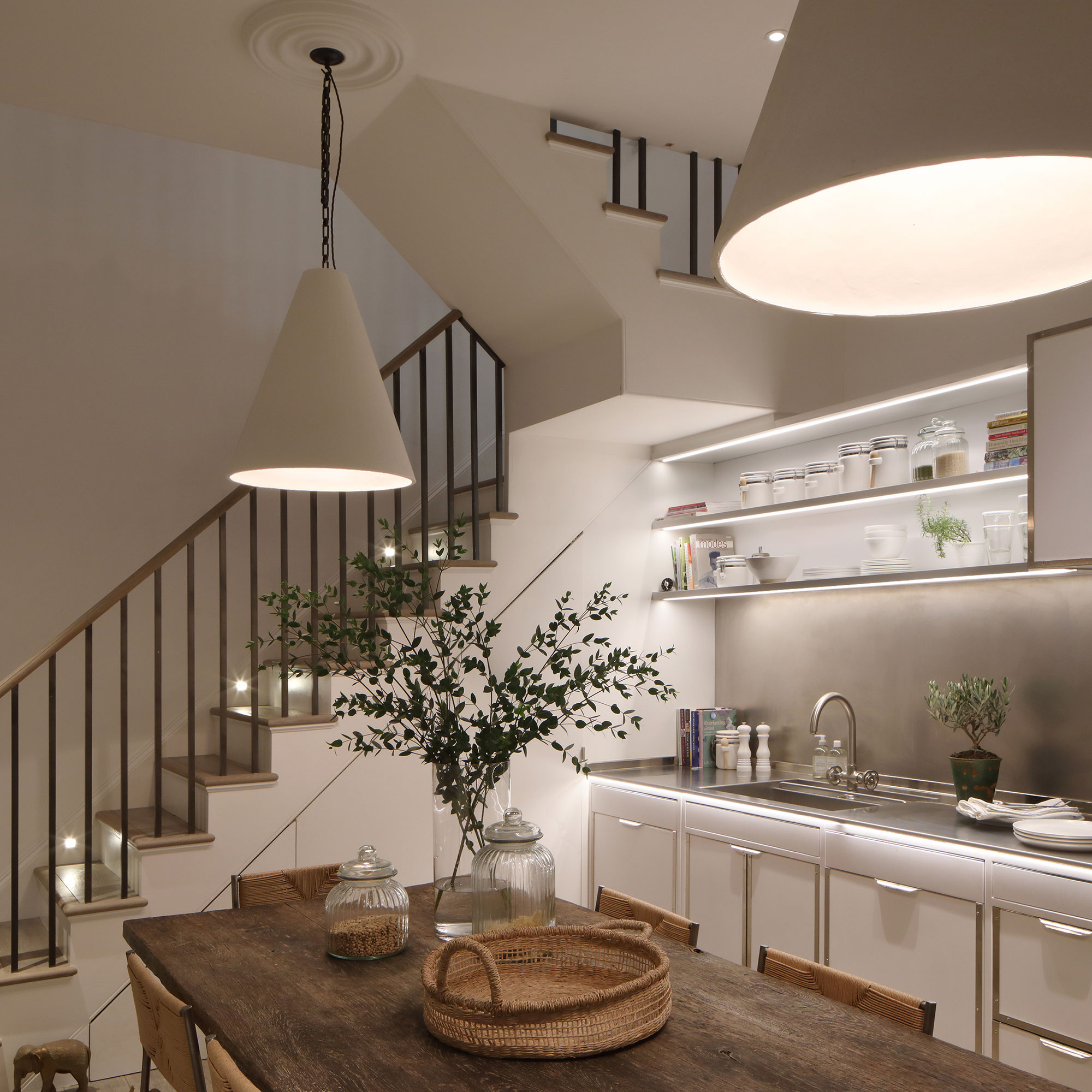Experts warn this is the biggest mistake people make when choosing lighting for their kitchen
Sticking to just cool lighting in your kitchen? It might not be the best choice for an inviting cooking space


Kitchen lighting will be the single most important thing you have to plan into your cooking space, and knowing how to do so effectively will completely transform how you use it. From ambient task lighting to bright white spotlights over a prep area, incorporating both options will mean your kitchen is ready for day-to-day tasks as well as relaxing evenings. But should kitchen lighting be warm or cool? We spoke to experts to decode which is best.
It can be tempting to go for functional bright white lights throughout a kitchen space to ensure that work surfaces are illuminated as well as possible ready for all the prep that cooking entails. However, kitchens are more multi-functional than ever before so creating an atmosphere ideal for dining, relaxing with family and entertaining well into the evening will be where warm lighting comes into play.
It can be tricky to know the kitchen lighting rules to adhere to, so we spoke to kitchen experts to figure out exactly where warm and cool bulbs are best positioned.
Should kitchen lighting be warm or cool?

A kitchen is a multi-functional space, which makes choosing lighting for the entirety of the room quite tricky. When planning a kitchen layout, you'll need to factor in a combination of overheard lighting and task lighting situated around the room to ensure that each and every corner is illuminated, and that every potential function is catered for.
Choosing solely warm or cool toned lighting for a kitchen might make a cooking space feel either too stark and clinical, or not illuminated enough. A combination of both warm and cool-toned lighting will be best, but which lights should be which?
'Choosing between warm or cool lighting for a kitchen depends on how you use the space and the atmosphere you want to create,' explains Molly Chandler, designer at Willis & Stone. 'Warm lighting works really well in kitchens with earthy tones, as it will help to enhance the beauty of wood cabinetry, stone worktop tops and other natural elements. It’s great for relaxation, creating a welcoming, cosy space, ideal for social gatherings.'
'Cool lighting, on the other hand, is bright and energising making it ideal for task lighting in areas where you need clear visibility, such as for food prep and cooking. In complements more modern kitchens, such as those with clean lines, white worktops and stainless steel appliances,' she adds.
Sign up to our newsletter for style inspiration, real homes, project and garden advice and shopping know-how
Where to use cool lighting in a kitchen

While many people veer away from cool-toned lighting in fear of a cooking space looking too clinical, it's a really effective bulb to use over practical areas that need ample illumination.
'The most effective kitchen lighting solution is to specify a scheme that allows bright task lighting over the countertops where the food preparation is taking place, and warm, low light over seating and gathering areas,' explains kitchen designer Tom Howley.
'There may only be a couple of metres between these two very different light sources, but it makes a world of difference to your guests’ entertaining experience and the host’s cooking experience.'

Cool-toned lighting can come in so many different sources. Under-cabinet lighting is a subtle way to introduce a bright white light and will help to illuminate the work surface directly beneath it, so factor this in when planning your kitchen lighting.
Adding spotlights under the very bottom of base cabinets will also add light to floors which is great for accessibility as well as setting the scene come evening. You could, of course, stick to a simple and traditional light in the form of a pendant hanging over an island which would provide a swathe of bright light.
To make it a little less stark, Tom suggests to 'consider dimmers and switches that allow you to brighten or lower the lights to create the right ambience for the occasion. Strategic lighting and seating solutions like this will encourage guests to relax and enjoy the informal kitchen dining experience.'
Where to use warm lighting in a kitchen

Although cool-toned lighting serves a purpose in terms of practicality, Jen Nash, head of design at Magnet argues that 'harsh lighting doesn’t belong in the kitchen. The kitchen as a space has evolved and has become the social hub of the home. With this in mind, it needs to be warm and welcoming, and harsh bright white lighting can completely eliminate any warm ambience.'
Kitchens are the heart of our homes, a spot where family and friends gather for a whole range of purposes other than simply cooking or eating, so you want your lighting to help set the scene.
'When choosing lighting for your kitchen, I’d always opt for a warmer-toned light as opposed to a white light. Whilst white lighting might be to some people’s taste, these bulbs give off an extremely clinical feeling which doesn’t feel particularly homely. Harsh lighting can also highlight any areas that might need cleaning, and make scuffs and scratch marks more visible,' Jen adds.

Warm lighting in the form of kitchen lamps or even kitchen wall lighting will add the perfect ambience to a cooking space. Whether you want to set the scene for a cosy weekend morning or create a glow for evenings spent enjoying a tipple (or two), warm lighting will make your kitchen a space you actually want to spend time in.
Ultimately, as kitchen designer Molly explains, 'clearly both bring their own benefits and the best approach is to choose a layered approach, allowing flexibility to adjust the lighting depending on the time of day or required atmosphere.'
'Use cool lighting for task lighting, such as for worktops, cooking areas or under cabinet lighting, and warm lighting for the main overhead fixtures or pendants. Warm lighting should also be used for any accent lighting, such as wall lights which highlight artwork or décor.'
Whichever you choose, a combination of both warm and cool lighting will be best in your kitchen. Think about which areas are made for practical purposes and those you want to be cosy, and the decision will be simple.

After starting out her journey at Future as a Features Editor on Top Ten Reviews, Holly is now a Content Editor at Ideal Home, writing about the best interior ideas and news. At Top Ten Reviews, she focussed on TikTok viral cleaning hacks as well as how to take care of investment purchases such as lawn mowers, washing machines and vacuum cleaners. Prior to this, Holly was apart of the editorial team at Howdens which sparked her interest in interior design, and more specifically, kitchens (Shaker is her favourite!).

